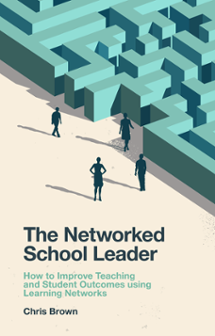
Index
Chris Brown
(Durham University, UK)
ISBN: 978-1-83867-722-0, eISBN: 978-1-83867-719-0
Publication date: 3 April 2020
This content is currently only available as a PDF
Citation
Brown, C. (2020), "Index", The Networked School Leader, Emerald Publishing Limited, Leeds, pp. 251-253. https://doi.org/10.1108/978-1-83867-719-020201013
Publisher
:Emerald Publishing Limited
Copyright © 2020 Chris Brown
INDEX
Accountability
, 116–118
Attainment gaps
, 117
Boundaries
, 53
Boundary objects
, 54, 64–69
Brokerage
, 53–76
Broker characteristics
, 69–72
Bronfenbrenner’s ecological systems theory
, 209–210
Brown, C.
, 15
Centrality
, 109
Change agents
, 98, 138
Chapman, C.
, 17, 18
Collaboration
, 18
aid and assistance
, 21
effective
, 19–20
historical
, 22
joint work
, 21
learning
, 1, 14
sharing
, 21
storytelling
, 21
Combination mode
, 59
Communities of practice
, 14, 15, 47, 64, 65
Competition
, 116–118
Concerns Based Adoption Model (CBAM)
, 99–100
Contrived collegiality
, 18
Critical consumers
, 208
Cultures
innovation
, 152–154
trust
, 152–154
Data Teams
, 26, 45
Decentralisation
, 114–115
Density
, 109
Developing Potential-Empowering schools project. See Pess networks
Distributed leadership (DL)
, 46–47, 125–128
models of
, 126
school leader capacity
, 128–130
approaches
, 204–205
PLN participants
, 205
Education networks
, 9–14
Effective collaboration
, 19–20
England
, 5, 12, 79–111, 137–162, 203–215
English system
, 117
Environmental conditions
, 114
Externalisation mode
, 59
Face-to-face communication
, 65
Facilitation
, 60
Formalise
, 40–43, 80, 122–124, 176, 203, 206
Geographical proximity
, 22
Germany
, 65, 79–111, 163–183, 185–201, 203–215
Great Education Reform Movement (GERM) systems
, 118
Hampshire research learning network
, 119–120, 160–161
Historical collaboration
, 22
Homogenous networks
, 20
Hubers, M. D.
, 53
Innovation
, 52–53
Instructional leadership
, 35
Internalisation mode
, 59
Interventions
, 56, 171, 211
Interviews
, 85–86, 90–95, 174
Joint practice development (JPD)
, 61
focused enquiries
, 69
structured peer observations
, 69
training students
, 69
Knowledge brokerage
, 53–76
Knowledge creation
, 59
Knowledge mobilization
, 14, 46, 86
Knowledge Network for Applied Education Research (KNAER)
, 11
Labyrinth
, 29–50, 203–215
Leadership
addendum
, 26–28
distributed leadership
, 125–130, 149–151, 204–205
professional learning networks (PLNs)
, 34–36
school leadership
, 168–169
Learning conversations
evidence and/or ideas
, 60
experience and external knowledge/theory
, 60
facilitation
, 60
protocols and tools
, 60
Learning organisations (LOs)
, 74
Liquid modernity
, 114
Literacy
, 117
Mobilise
, 40, 51, 130–131, 149, 198, 204
Multi-Academy Trusts (MATs)
, 113
Mutual learning
, 23
Ofsted
, 115–117, 123
Opinion formers
, 72, 73, 81
Optimum design
, 108
Organisational goals
, 35, 36
Pedagogic leadership
, 129
Perceived benefits
, 192–193
Performance management targets
, 42, 122, 134, 135, 206
Pess networks
, 3, 6, 109–111, 185–201
formalizing
, 176–177, 186–188
internal evaluation data
, 166
learning networks
, 169–172
local education networks
, 166–167
mobilizing
, 177–180, 188–192
new governance model, (NGM) 165
PISA
, 165–166
PLN benefits
, 180–181
prioritizing
, 174–176, 186–188
research findings
, 174
school leadership issues
, 168–169
socio-economic status (SES)
, 164
stages
, 172
time
, 182
voluntary based PLNs
, 168
Pess survey
, 109–111
Poortman, C.
, 1, 15
Practitioner-based social capital (PBSC)
, 47
Prioritisation
, 40–41, 122–124, 154, 203, 206–207
Professional development
, 86, 101, 115, 152, 162
Professional learning communities (PLCs)
, 92, 103, 149
within-school
, 43, 53, 56
Professional Learning Network (PLN)
benefits
, 16–17
defined
, 14
Germany and England
, 79–111
labyrinth
, 33
leadership
, 34–36
success conditions
, 17–26
Quasi-market pressures
, 116
Queens University, Canada
, 108
Reflective professional inquiry
, 23, 26, 58
Relevance benefits
, 192–193
Research-informed teaching practice (RITP)
, 81, 119, 169
Research Learning Network (RLN)
, 3, 80, 97, 113–135, 137–162
accountability
, 116–118
competition
, 116–118
decentralization
, 114–115
distributed leadership
, 125–128, 149–151
Dreyfus model
, 138–140
formalizing
, 122–124
Hampshire research learning network
, 119–120
innovations
, 144–149
mobilising approaches
, 130–131
participants
, 156–160
prioritizing
, 122–124, 154–156
research findings
, 121–122
resources
, 131–132
school findings
, 132–134
school improvisation
, 120–121
self-improvement
, 114–115
survey data analyzing
, 140–144
work-related networks
, 151–152
School budgets
, 131–132
budget cuts
, 44
School governors
, 123, 133, 134
School Improvement Plan
, 29, 115, 135, 192, 206
School leaders
, 35, 49
Self-improvement
, 114–115
Self-organising distributed leadership
, 199–200
Senior leader
, 35, 122, 130, 160, 198
Socialisation mode
, 59
Staff engagement
, 198–201
Staff meetings
, 45, 55, 128
Stoll, L.
, 49
Storytelling
, 21
Student outcomes
, 11, 17, 44, 61, 129
Survey design
, 108–109
Sustainability
, 138, 194–198
Teachers
, 3
collaboration
, 13
interviews
, 85–86
joint work
, 21
Pess networks
, 163–183
practice
, 16
priorities
, 41
Professional Learning Network (PLN)
, 34
reflection and inquiry mindedness
, 16
research learning networks
, 113–135
self-improvement
, 13
skills and knowledge
, 9
sustained learning
, 20
Teaching assistants
, 128, 129
Teaching practices
, 1, 33, 81, 152
Theories of action (ToA)
, 63
Transformational leadership
, 35
Trust
, 20, 74, 137–162
Virtuous cycle
, 117
Within-school factors
, 35
- Prelims
- Introduction
- 1 The Current Context for Professional Learning Networks
- 2 The Labyrinth
- 3 Connecting PLN Learning with What Happens in Schools
- 4 How Can We Learn from PLNs in Germany and England?
- 5 Research Learning Networks in England: What Do Teachers and School Leaders Say?
- 6 Research Learning Networks in England: Exploring Social Networks, Cultures of Trust and Innovation
- 7 Pess Networks in Germany: Hearing the Voices of Teachers and School Leaders
- 8 Pess Networks in Germany: Examining the Use and Value of Networked Learning
- 9 Conquering the Labyrinth: Lessons Learned from Cases in England and Germany
- Notes
- References
- Index